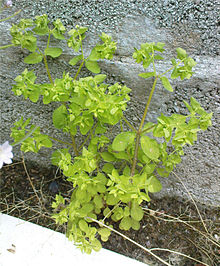Euphorbia peplus
| Euphorbia peplus | |
|---|---|

| |
| Scientific classification | |
| Kingdom: | |
| (unranked): | |
| (unranked): | |
| (unranked): | |
| Order: | |
| Family: | |
| Genus: | |
| Species: | E. peplus
|
| Binomial name | |
| Euphorbia peplus | |
Euphorbia peplus (petty spurge,[1][2] radium weed,[2] cancer weed,[2] or milkweed[2]) is a species of Euphorbia, native to most of Europe, northern Africa, and western Asia, where it typically grows in cultivated arable land, gardens, and other disturbed land.[1][3][4]
Outside of its native range it is very widely naturalised and often invasive, including in Australia, New Zealand, North America, and other countries in temperate and sub-tropical regions.[1]
Description
It is an annual plant growing to between 5–30 cm tall (most plants growing as weeds of cultivation tend towards the smaller end), with smooth hairless stems. The leaves are oval-acute, 1–3 cm long, with a smooth margin. It has green flowers in three-rayed umbels. The glands, typical of the Euphorbiaceae, are kidney-shaped with long thin horns.[4]
Medicinal uses
The plant's sap is toxic to rapidly replicating human tissue, and has long been used as a traditional remedy for common skin lesions, including cancer.[5] The active ingredient in the sap is a diterpene ester called ingenol mebutate. A pharmaceutical-grade ingenol mebutate gel has approval from the US Food and Drug Administration for treatment of actinic keratosis.[5][6][7]
References
- ^ a b c "Germplasm Resources Information Network".
- ^ a b c d Hazel Dempster; Bronwen Keighery; Greg Keighery; Rod Randall; Bob Dixon; Bill Betts; Margo O'Byrne; Diane Matthews. "Euphorbia terracina Workshop Proceedings 2000" (PDF).
- ^ Flora Europaea: Euphorbia peplus
- ^ a b Blamey, M. & Grey-Wilson, C. (1989). Flora of Britain and Northern Europe. ISBN 0-340-40170-2
- ^ a b Siller G, Gebauer K, Welburn P, Katsamas J, Ogbourne SM (2009). "PEP005 (ingenol mebutate) gel, a novel agent for the treatment of actinic keratosis: results of a randomized, double-blind, vehicle-controlled, multicentre, phase IIa study". Australas J Dermatol. 50 (1): 16–22. doi:10.1111/j.1440-0960.2008.00497.x. PMID 19178487.
- ^ Lebwohl, M, et al. "Ingenol Mebutate Gel for Actinic Keratosis." N Engl J Med 366;11, March 15, 2012.
- ^ "FDA Approves Picato® (ingenol mebutate) Gel, the First and Only Topical Actinic Keratosis (AK) Therapy With 2 or 3 Consecutive Days of Once-Daily Dosing". eMedicine. Yahoo! Finance. January 25, 2012.
External links
- Euphorbia
- Flora of Africa
- Flora of Asia
- Flora of Europe
- Flora of Lebanon
- Poisonous plants
- Medicinal plants of Africa
- Medicinal plants of Asia
- Medicinal plants of Europe
- Invasive plant species in Australia
- Invasive plant species in New Zealand
- Invasive plant species in the United States
- Plants described in 1753
- Euphorbia stubs
- Medicinal plant stubs
